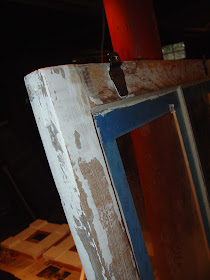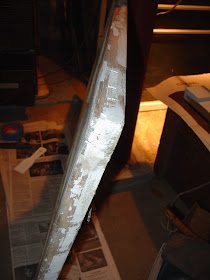When we moved in, the paint on two sides of the house was in especially bad shape. The side nearest the road had be painted before we closed, for the bank to approve the mortgage. A contractor did that.
We decided we'd handle the rest.
So far, 19 months later, we've painted the back additions ... and, ... I have restored one kitchen storm window. It only took me a year. At that rate, well, let's just say I'll be dead before they're all done. But, at least this one was in by far the worst shape.
In any case, since I didn't have a blog at that point, I don't have a good "before" photo. Here's the back of the house on our second viewing on February 27, 2011, nearly two years ago to the day, today.
You can see the amazingly beautiful rolled steel roof we had to remove and replace, too. It wasn't the original roof. The original roof (helpfully still underneath the steel roof) was cedar shingle. And beneath that, nothing. Alas, both had to go, and now there is a regular old composite asphalt roof on the house. I wish we had had another decent option, but we didn't. In any case, here you see the back of the house, original kitchen window and storm on the lower right, to the left of the kitchen addition.
And, a very poor close-up of the window. The detail is bad, but basically, all the glazing putty had dried up and fallen out of the storm, and the muntins had lost their paint and warped free of the frame in places, and the window panes were loose and in danger of falling out.
I knew when I took the storm off, to shore up and paint the exterior casing of the window, that it couldn't go back on as is.
So I took it down, took the glass out, marking each piece, cleared the old glazing putty and paint, refastened the muntins, learning about simple window construction in the process. Then I chiseled the paint away from the rest of the window, getting the surfaces as smooth as possible, and finally, filled the gaps with a regular wood filler in some places and Minwax two-part wood filler in others.** [See note below about wood fillers and epoxy.]
This whole process took maybe a month, and at that stage, right before winter settled in for good, I reglazed the window and, finally, took some photos.
The horizontal muntin here, below, had warped entirely free of the frame (stiles) here, and as you can see, it's now more or less flush, having been refastened and then filled.
The bottom rail, below right, had shrunk away from the right stile here. After clearing most of the old paint, I filled this with two-part wood filler.
That was the point at which I burned out, despite the fact that it was a relatively small project. And so, the window sat, first in the garage and then in the basement for a whole year, until I was painting the porch column bases this fall. Then I taped and painted it, finally. And took a few more photos, that show its classic storm window construction.
So, this is the only storm window left in the house that has four panes. All of the downstairs storms that are intact are two paned, one up and one down. The upstairs windows all have their storms intact, too, but that's a different matter, for later posts.
So this one is unique. We're looking at the inside of the storm. You can see the metal handle on the bottom rail, that lets you pull it towards you (or push it out for some air).
Here is the inner upper-right corner:
Inner horizontal muntin, right hand side. This didn't need repair:
Here is a photo of the outside of the storm, which was in kinda bad shape. You can see the hanging fasteners, which I've painted with black Rustoleum. It's still totally possible to get a version of these fasteners at House of Antique Hardware, here. And, our Lowe's carries another version, too.
Here's a close-up:
Bottom right corner, again, same deal:
And, some different angles, showing the construction. If you look closely, you can see the join between the right stile and upper rail:
This is a photo of the right side of the storm (right side, if it's installed and you're looking at it from the exterior of the house, that is), showing the classic mortise and tenon joint, where the bottom rail fits into the right stile:
Here you can see the same tenon joint construction where the upper rail is joined to the left stile:
And, one more view of a tenon. I show all these because I haven't seen and can't find any detailed descriptions or photos of the construction of old wooden storm windows, anywhere.
And, finally, before:
And -- after:
And last, today, doing its job holding out the snow and mist -- hook and eye holding it snug to the window frame (which, of course, needs to be painted ...).
By the way, I found another blog with very detailed descriptions of the carpentry required to make a storm window that is pretty much exactly like mine here, at the Bytown House blog by a blogger in Shaker Heights, Cleveland -- near where I grew up.
**March 11, 2013 Update: Over the winter, I have done some more research on wood fillers and wood epoxies. I am seeing some reviews that the Minwax two-part wood filler is not a true epoxy and doesn't hold up well over time in exterior uses with northern winters. Abatron seems to be the most used epoxy. A good explanation is on the Minnesota Window Restoration blog here























Storm-proofing your windows will really prove it’s worth come the rainy and snow seasons. It can be quite an effort to do so despite being a small project, but at least you won’t have problems with it in the future and you’ll be able to focus on the other possible problems that may arise from stormy weather.
ReplyDeleteLino @ Arrys Roofing
Yeah. Some wood epoxies and fillers tend to not last in very cold weathers. From what they’ve said, Abatron seems to be effective in standing up to storms and the winter season. The window looks great, btw; though with the other windows being two-paned, wouldn’t it be better if you used a two-paned for that one too?
ReplyDeleteCharles
Charles - You're completely right about the main sash being six over six and the storm two over two, but that's the way the house came. I like it! Every other storm on the ground floor is one over one. I don't know why this one is two over two. Pugsley is full of these historical accidents and I love that about it as a house. It has a past, often an unexplained, mysterious past full of the sense of other people who lived here and did things in the moment because it was needed. Sometimes I can't help but amuse myself by imagining what fluke of history caused such discrepancies, and sometimes the causes seem significant, but in this case, I just think that the storm was either made when two over twos were the window of the time (i.e., after six over sixes and before one over ones), or, more likely, that someone (very like me) plucked it out of the trash and repurposed it.
DeleteYour new window looks great! It’ll certainly help hold out the weather and keep in the heat better now that you’ve refurbished it. And thank you for that storm window link at the end. It would definitely be useful when the time comes to change our own windows.
ReplyDelete